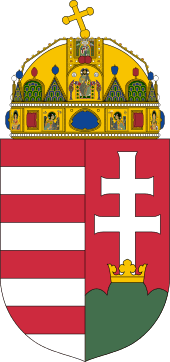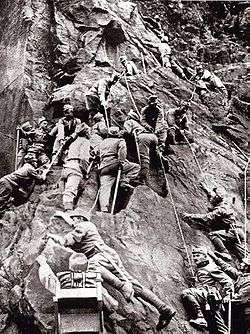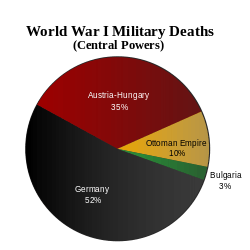Hungary in World War I
At the outbreak of World War I, Hungary was part of the dualist monarchy, Austria-Hungary. Although there are no significant battles connected to Hungarian regiments, the troops fought faithfully and intrepidly, which was one of the causes of high losses.
Part of a series on the |
||||||||||||||||||||
|---|---|---|---|---|---|---|---|---|---|---|---|---|---|---|---|---|---|---|---|---|
| History of Hungary | ||||||||||||||||||||
 | ||||||||||||||||||||
|
Medieval
|
||||||||||||||||||||
|
Early modern
|
||||||||||||||||||||
|
Late modern
|
||||||||||||||||||||
|
Contemporary
|
||||||||||||||||||||
|
By topic |
||||||||||||||||||||
|
| ||||||||||||||||||||
The outbreak of the war
In 1914, Austria-Hungary was one of the great powers of Europe, with an area of 676,443 km² and a population of 52 million, of which Hungary had 325,400 km² with population of 21 million.
On June 28, 1914, Gavrilo Princip assassinated Archduke Franz Ferdinand of Austria. Before entering the war, only the prime minister Count István Tisza hesitated, unconvinced that it was the best time to engage in battle. As soon as Germany promised to neutralize the Kingdom of Romania and promised that no territories of the Kingdom of Serbia would be annexed to Austria-Hungary, he then decided to support the war.
After the ultimatum sent to Serbia by Franz Josef I, the war broke out and soon spread over much of Europe and beyond.
The army of Austria-Hungary in 1914
The first line of this multi-ethnic army was based and consisted of:
- The so-called "common" army and "common" navy, where the language was German, and was 87% of the total army
- The Landwehr of the Austrian army
- The Royal Hungarian "honvédség", where the language was Hungarian and Croatian.
The second line of the army was the mobilized
- Landsturm of the Austrians
- "Népfelkelés" ("Folk uprising") of Hungarians.
In 1914, the Austrian-Hungarian army was facing its greatest challenge so far in history. After mobilisation, the armed forces were grouped to six armies, totaling 3.2 million soldiers. Between 1914 and 1918, 9 million served in the army (7.8 million in the fighting forces).
In comparison to the other armies of Europe, Hungary's experienced veteran armed forces, technical equipment, and military expenditures were underdeveloped. The artillery was not sufficient, but it was heavily developed later in the war. The correct supply of ammunition was not solved even by the end of the war. The armed forces lacked an adequate air force: it had only 42 military and 40 sport airplanes before the war. Unifying the multi-ethnic units was also a serious problem for the military's leaders.
Hungarian participation
The military forces of Austria-Hungary remained largely unified over the course of the war, in spite of their multi-ethnic nature and some expectations to the contrary. While German support was undoubtedly critical to the success of various offensives (such as the Gorlice-Tarnow Offensive and the Battle of Caporetto), the multi-ethnic armies of Austria-Hungary proved fully capable in a defensive role in all the theaters of the war in which they were engaged.
The pre-dominantly ethnic German commanders of the army generally favored troops of German extraction, but ethnic Hungarian troops were also seen as being reliable and were widely used on the front lines, especially on the Russian front and Italian front. For the most part, troops from other ethnic groups within the empire were less likely to be placed in strategically critical positions and therefore had lower casualties.
Over the course of World War I there was never a documented offensive by purely ethnic Hungarian troops, but such troops did contribute positively to the outcome of various battles, as follows:
- On December 3–15, 1914 during the Battle of Limanowa, the "Russian steamroller" was held back, especially by the hussars. Lieutenant-general Josef Roth attacked the Russian 3rd army, and on the right wing, the 10th Budapest and 11th Debrecen cavalry divisions engaged in a man-to-man fight and were decisive. On December 11, colonel Ottmár Muhr died in a heroic defense leading the Sopron 9th cavalry regiment. Lieutenant-general Artur Arz, together with lieutenant-general Imre Hadfy, leading the 39th Kassa division, destroyed the 15th Russian division in Livno.
- During the Siege of Przemysl, which defense was commanded by general Hermann Kusmanek, the main defence line, consisting of Hungarian troops, guarded the fortress for five months from November 1915. The defenders were commanded by Árpád Tamásy, leading the 23rd Szeged division. After the depletion of ammunition and food reserves, Przemysl capitulated, leaving 120,000 prisoners of war.
- On the Isonzo front, Hungarian forces participated in all twelve battles. On the Doberdo plateau and near Karst, the most serious battles were fought by Hungarians, who composed one third of the total armed forces. In particular, the 20th Nagyvárad and 17th Budapest common regiments distinguished themselves. On June 15, 1918, near the river Piave, the 6th army commanded by Archduke József Ágost took over most part of mount Montello and held it until the end of the war. Decisive fights were carried out by the 31st Budapest common regiment and the 11th Debrecen division.
The troops raised in the Kingdom of Hungary spent little time defending the actual territory of Hungary, with the exceptions of the Brusilov Offensive in June 1916, and a few months later, when the Romanian army invaded Transylvania, both of which were repelled. A small number of troops from Austria-Hungary also fought in more distant theaters of war that are beyond the borders of the Austria-Hungary, including the Gallipoli campaign, and in the Sinai Peninsula and Palestine.
Military leaders

Some military leaders who have received the Commander's Cross of the Military Order of Maria Theresa, the most renowned medal:
- Colonel-General Arthur Arz von Straussenburg
- 1914 December - Battle of Limanowa
- 1915 May - Gorlice-Tarnow Offensive, leading legion Kassa 6.
- 1916 October - leading 1st army, defending Transylvania from Romanian forces
- Archduke Joseph August of Austria
- 1915 - during the 2-4 Battle of the Isonzo, he defended Doberdo plateau
- 1916 December - constable of army, successful offensives in Russian front
- Field-marshal Hermann Kövess von Kövessháza
- 1915 August - leading legion Nagyszeben 12., he captured Iwanogród
- 1915 October - commander of 3rd army, occupied Kingdom of Serbia
- 1916 January–February - occupied Montenegro and north of Albania
Losses

Out of over 8 million men mobilized in Austria-Hungary, more than one million died during the course of the war. In Hungarian areas, this meant a death rate of twenty-eight per thousand persons - a level of loss exceeded within Austria-Hungary only by German Austrians.[1] In comparison to the total army, Hungary's loss ratio was more than any other nations of Austria-Hungary. There could be two possible causes: Hungary was more an agricultural country, where it is easier to mobilize forces, rather than from more industrialized territories (i.e. Bohemia), and secondly, the Hungarian soldiers were considered to be more trustworthy and disciplined than soldiers from other ethnic groups.
The war aims of Hungary
In contrast to the cases of Germany, France or Italy, the question of World War I aims of Hungary remains almost unexplored. However, as the Kingdom of Hungary was the most politically stable part of the Habsburg Monarchy, it strongly impacted the Dual Monarchy's war plans. The main concerns of the government in Budapest were directed by the fears for the integrity of Hungary. In July 1914, its Prime Minister, István Tisza, convinced the Monarchy's Crown Council not to demand new territories from Serbia. In parallel, the Hungarian opposition secretly informed the Entente that an independent Hungary could be proclaimed, ready to sign a separate peace treaty if her frontiers were guaranteed. An opposition leader, Mihály Károlyi, entered into contacts with Italians, British and French. In the autumn of 1915, with Austro-Hungarian army’ successes, the secessionist moods in Budapest cooled down. Hungarian politicians turned towards the annexation of Northern Serbia, and possibly Montenegro. When Austria envisaged the joining of Poland, Tisza insisted in Vienna to include Bosnia-Hercegovina (and probably Dalmatia) in Hungary. However, when Romania declared war on the Habsburg Monarchy in August 1916, the Tisza government anticipated annexations of Romanian lands, whereas the Hungarian radical opposition in the parliament (independentists, led by Mihály Károlyi), reinforced the separatist propaganda. In March 1917, Tisza proposed to the Crown Council of the Monarchy to divide Romania between Hungary and Russia, leaving a little Romanian buffer State. Yet, according to the Bucharest Peace Treaty (7 May 1918), Romania only ceded Carpathian mountain passes to Hungary. The next "success" of Hungarian territorial expansionism was the Habsburgs approval of the attachment of Bosnia-Herzegovina and Dalmatia to the Kingdom in October 1918. Expecting the collapse of the Central Powers, Károlyi was allowed by the Imperator-King to form a government in Budapest. This government declared the independence of Hungary on 31 October 1918. However, it did not stop the Entente and its allies from raising territorial claims against Hungary. They finally acquired three quarter of pre-war Hungary by the Peace Treaty of Trianon (4 June 1920).[2]
Aftermath
In November 11, 1918, World War I ended for Austria-Hungary with a complete military loss, even if at the time of the collapse, all forces were standing outside of borders of 1914. With the collapse of the army, Austria-Hungary also collapsed. The ethnic groups of Kingdom of Hungary called for independent nation-states. In the Treaty of Trianon signed on June 4, 1920, Hungary lost two-thirds of its territory, more than half of its population, more territory than any other country at that time (excluding colonies). Eight million Hungarians left in Hungary and more than 3 million Hungarians were stranded outside of the newly established borders. New nations, such as Czechoslovakia, Poland, and Kingdom of Serbs, Croats and Slovenes were established and some already existing countries have extended their territories (Italy and Romania). The southern part of Hungary was given to Yugoslavia and renamed Vojvodina. Bosnia-Herzegovina was also incorporated in Yugoslavia and Croatia became part of Yugoslavia also, after a 900 years federation with Hungary. More than 104.000 square km — the whole of Eastern Hungary and Transylvania — were awarded by the Entente to Romania, more than what was left for Hungary itself 93.030sq.km. The northern part of Hungary was annexed by the newly created Czechoslovakia.
These newly created or greatly enlarged states formed the Little entente after the war encircling Hungary in order to make border reestablishment impossible. The Hungarian Army was reduced to a mere 30.000 troops, Hungary was forbidden to have air force, tanks and any more sophisticated weapons. The borders were set in such a way that all natural defense lines were crossed making the remaining territory totally vulnerable and difficult to defend. The Czechoslovak border was drawn at 30 km from Budapest to put the city in the range of the Czechoslovak cannons aligned on the border.
See also
References
- ↑ Rothenburg, G. The Army of Francis Joseph. West Lafayette: Purdue University Press, 1976. p 218.
- ↑ A. Piahanau. "Hungarian War Aims During WWI: Between Expansionism and Separatism." Central European Papers 2#2 (2014): 95-107. http://www.slu.cz/fvp/cz/web-cep-en/journal-archive/copy_of_2013-vol-1-no-1/20140202_piahanau
Further reading
- Jozsef Galantai. Hungary in the First World War. Budapest : Académiai kiado, 1990. ISBN 978-9630548786
- Deak, John. "The Great War and the Forgotten Realm: The Habsburg Monarchy and the First World War," Journal of Modern History (2014) 86#2 pp 336–380.
- Piahanau, Aliaksandr. "Hungarian War Aims During WWI: Between Expansionism and Separatism." Central European Papers 2#2 (2014): 95-107.http://www.slu.cz/fvp/cz/web-cep-en/journal-archive/copy_of_2013-vol-1-no-1/20140202_piahanau
In Hungarian
Tibor Balla (2001). "Magyarország az első világháborúban". The Illustrated History of World War I. By Wiest, Andy. London: Amber Books Ltd., reprint in Hungarian by M-érték Kiadó Kft. ISBN 963-9519-28-6.